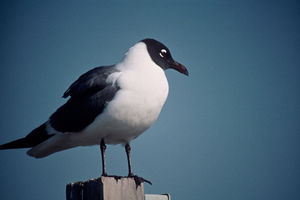Aztec gull
| Aztec gull | ||||||||||||
|---|---|---|---|---|---|---|---|---|---|---|---|---|

Aztec gull ( Leucophaeus atricilla ), summer plumage |
||||||||||||
| Systematics | ||||||||||||
|
||||||||||||
| Scientific name | ||||||||||||
| Leucophaeus atricilla | ||||||||||||
| ( Linnaeus , 1758) |
The Aztec gull ( Leucophaeus atricilla , Syn . : Larus atricilla ) is a North American species of gulls (Larinae). She can occasionally be observed as a stray visitor in Europe . It is most common in Great Britain and Ireland, while it is an extremely rare exceptional guest in Central Europe .
The zoological epithet atricilla is made up of the two Latin words ater for black and cilla for tail . A black band on the tail does not show it until the third year.
features
The medium-sized and long-winged Aztec gull with a body length of about 37 to 42 cm and a wingspan of 98 to 110 cm can hardly be confused with other gulls. From the third year the head, legs and feet are black, while the long, slightly curved beak is red. The forehead is flat and the eyes have thin, white, crescent-shaped spots above and below. The top of the wing is dark gray and the wing feathers are black on the outside. In winter, the plumage turns white and the beak turns black.
The juvenile plumage is speckled brown, while the belly is pale gray and the bill, outer flight feathers, legs, feet and tail are black. The whole head is feathered in a warm brown tone. The first winter dress shows a dark gray back, and the head and neck gradually change to white. In the second winter this white is dirtier and almost the whole tail is also white.
The very loud call sounds like a confused, rough and very high-pitched laugh.
Occurrence
Aztec gulls are commonly found on the east coast of the United States . Further north they are only represented in summer. The breeding areas extend from the coasts of Florida over the Caribbean and Californian to the northern coasts of South America , more rarely they migrate to Western Europe .
nutrition
The food spectrum of the Aztec gulls consists of aquatic invertebrates , insects , worms , carrion and occasionally fish . If possible, like most seagulls, they steal other birds' food, or eggs and chicks from foreign nests. The food is either picked up on the beach and then dipped in, or other birds are attacked in flight until they drop their prey. However, Aztec gulls are by no means as aggressive as many other gulls, except for the chicks of the Arctic tern ( Sterna paradisaea ), where the aggressions have even increased in recent years. Aztec gulls also eat less plant-based food.
Reproduction
The breeding season of the monogamous Aztec gulls begins in early April and lasts until July. The nesting colonies can be very large. Usually, the nests are built near the coast on the ground or in the beach vegetation, in river deltas or on ponds . The female lays two to four (usually three) greenish eggs and both adult birds incubate them for about 21 to 23 days. The chicks do not leave the nest until a few days after hatching. The adult birds take care of them for about 35 days.
literature
- Cathie Katz: The nature of Florida's beaches. Great Outdoors, Saint Petersburg 2001, ISBN 0-8200-1201-7 .
- GK Noble, M. Wurm: The social behavior of the Laughing gull. In: Annals of the New York Academy of Sciences . vol. 45, New York 1943, pp. 179-220.
Web links
- Videos, photos and sound recordings of Larus atricilla in the Internet Bird Collection
- Larus atricilla inthe IUCN 2013 Red List of Threatened Species . Listed by: BirdLife International, 2012. Retrieved January 14, 2014.
Single receipts
- ↑ Hans-Günther Bauer, Einhard Bezzel , Wolfgang Fiedler (eds.): The compendium of birds in Central Europe: Everything about biology, endangerment and protection. Volume 1: Nonpasseriformes - non-sparrow birds. Aula-Verlag Wiebelsheim, Wiesbaden 2005, ISBN 3-89104-647-2 , p. 591.

